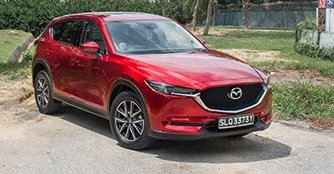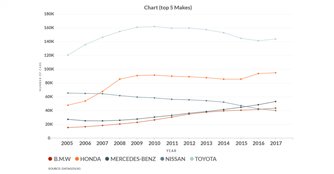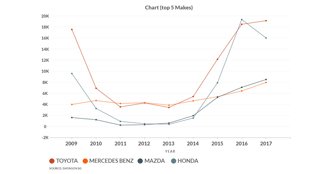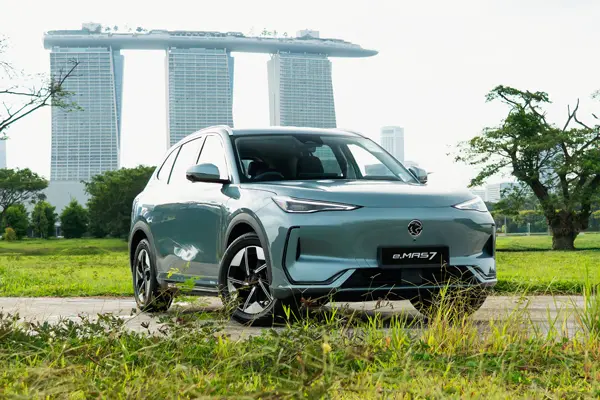Is Nissan and Toyota losing their magic in Singapore?
20 Sep 2018|16,736 views
Nissan is clearly going down.. down.. down?
The top five car makes in Singapore by total number on the roads are Toyota, Honda, Mercedes-Benz, BMW and Nissan, in that order.
However, Nissan appears to be going on a steady downward trend here, in the car population chart (pictured right, from Data.gov.sg).
Does that mean that you should avoid buying them?
Honda is closing in on Toyota!
Although in terms of total cars on the roads, Toyota reigns supreme, but its market share for new car sales in Singapore is close to, or marginally higher, than its rival Honda.
Will the two carmakers eventually change position? Toyota has been leading the game for the past decade with Honda being her closest competitor.
But since 2014, Honda has been closing that gap, and has overtaken Toyota in 2016 (pictured right, from Data.gov.sg).
Click here for new Toyota cars
Click here for new Honda cars
A new world-order: Mazda is third
The top five car makes in Singapore for car population are Toyota, Honda, Mercedes-Benz, BMW and Nissan, in that specific order.
But when we look at the top five makes for new cars registered in 2017, Mazda ranks third, with 8,509 cars sold and a market share of 9.3%. It leapfrogged both BMW and Nissan, which sold 5,591 and 5,241 new cars each, respectively. What happened?!
The miraculous rise of Mazda
Up till 2012, Mazda was actually doing quite miserably in Singapore. Today, it's the third highest selling new car brand trailing behind Toyota and Honda. Will Mazda eventually replace Nissan's fifth-place standing on the car brand population chart? Hmm, let's check out the international scene first.
According to a Business Times report in 2017, when Eurokars took over the Mazda franchise in 2011, its share was languishing at 0.9%. Back then, things looked bleak for Mazda at home, too.

And with the new CX-5 launched last year, Hiroshi Inoue, who oversees Mazda's sales for the Asean region, says the brand's Asean sales could grow nearly 50% to 150,000 cars in just two years. Eurokars, meanwhile, is preparing for growth here, too. This year, the group will open a new 438,000 sq ft aftersales centre.
More than 60% of the floorspace will be used for Mazda operations. The Eurokars Group manages five brands in Singapore: Porsche, Rolls-Royce, MINI, Mazda and McLaren.
Click here for new Mazda cars
Nissan is doing better than you think!
It's actually ranked fourth in terms of global sale for 2017. And according to figures tabulated by the manufacturer, Renault-Nissan improved their performance by a whopping 10.4%!
Click here for new Nissan cars
Three major takeaways:
1. Does that mean that you should avoid buying Nissan?
No. You need not avoid buying it. But you should perhaps consider the factors why Nissan is losing popularity here. Is it a local distributorship issue? Or is it due to other factors? To compound the problem for Nissan, when private-hire companies in Singapore bulk purchased their vehicles in 2016, Nissan models were not in their buy list, too.
Note: We may write a separate article next time to explore deeper on the possible reasons behind the downward trend of Nissan.
2. Will the two carmakers eventually change position?
Although it is possible that Honda will replace Toyota as the dominant player here, just like how Mazda managed to overtake two competitors to be in third position, it is not likely to happen in the next five years.
Toyota is still leading by a good margin ahead of Honda. Toyota will have to make a drastic mistake to lose its pole position. However, if we look at how well it is doing internationally, they are not likely to commit such errors.
However, let us not forget the mass retrenchment exercise that took place in early 2017. More than 100 Singapore employees were retrenched due to Inchcape's restructuring exercise of its Asian operations.
The number of workers retrenched represented 12% to 14% of Inchcape's workers in Singapore. Several senior employees, including Chief Executive for South Asia and Managing Director of Toyota agent Borneo Motors Koh Ching Hong, were affected.
Subsequently, Inchcape picked Ms. Jasmmine Wong, an industry outsider, to be the Managing Director of Inchcape (Singapore) with effect from July 2017. Ms. Wong is also the first female chief for their Singapore office.
The many other top management positions cut were being replaced by expatriates brought in from HQ or other regional offices. Since Inchcape is responsible for the Toyota, Suzuki and Hino franchises in Singapore, it is hard to predict how the massive management change will affect Toyota's operations and sales performance.
3. Will Mazda eventually replace Nissan's fifth-place standing on the car brand population chart?
The possibility is quite high. At present, Mazda is actually in sixth position, lagging behind Nissan by 9,000 vehicles in 2017. Based on the figures for registration of new cars, Mazda and Nissan had 8,509 and 5,241 cars registered, respectively, in 2017.
So Mazda is around 3,000 cars ahead of Nissan for a 12-month period. If the sales figures for 2017 remain constant for the next few years, Mazda will have replaced Nissan's fifth-place standing in just three years.
Note: We are not taking in consideration the number of Nissan or Mazda cars that will be deregistered over the next few years.
More than 60% of the floorspace will be used for Mazda operations. The Eurokars Group manages five brands in Singapore: Porsche, Rolls-Royce, MINI, Mazda and McLaren.
Click here for new Mazda cars
Nissan is doing better than you think!
It's actually ranked fourth in terms of global sale for 2017. And according to figures tabulated by the manufacturer, Renault-Nissan improved their performance by a whopping 10.4%!
Click here for new Nissan cars
Three major takeaways:
1. Does that mean that you should avoid buying Nissan?
No. You need not avoid buying it. But you should perhaps consider the factors why Nissan is losing popularity here. Is it a local distributorship issue? Or is it due to other factors? To compound the problem for Nissan, when private-hire companies in Singapore bulk purchased their vehicles in 2016, Nissan models were not in their buy list, too.
Note: We may write a separate article next time to explore deeper on the possible reasons behind the downward trend of Nissan.
2. Will the two carmakers eventually change position?
Although it is possible that Honda will replace Toyota as the dominant player here, just like how Mazda managed to overtake two competitors to be in third position, it is not likely to happen in the next five years.
Toyota is still leading by a good margin ahead of Honda. Toyota will have to make a drastic mistake to lose its pole position. However, if we look at how well it is doing internationally, they are not likely to commit such errors.
However, let us not forget the mass retrenchment exercise that took place in early 2017. More than 100 Singapore employees were retrenched due to Inchcape's restructuring exercise of its Asian operations.
The number of workers retrenched represented 12% to 14% of Inchcape's workers in Singapore. Several senior employees, including Chief Executive for South Asia and Managing Director of Toyota agent Borneo Motors Koh Ching Hong, were affected.
Subsequently, Inchcape picked Ms. Jasmmine Wong, an industry outsider, to be the Managing Director of Inchcape (Singapore) with effect from July 2017. Ms. Wong is also the first female chief for their Singapore office.
The many other top management positions cut were being replaced by expatriates brought in from HQ or other regional offices. Since Inchcape is responsible for the Toyota, Suzuki and Hino franchises in Singapore, it is hard to predict how the massive management change will affect Toyota's operations and sales performance.
3. Will Mazda eventually replace Nissan's fifth-place standing on the car brand population chart?
The possibility is quite high. At present, Mazda is actually in sixth position, lagging behind Nissan by 9,000 vehicles in 2017. Based on the figures for registration of new cars, Mazda and Nissan had 8,509 and 5,241 cars registered, respectively, in 2017.
So Mazda is around 3,000 cars ahead of Nissan for a 12-month period. If the sales figures for 2017 remain constant for the next few years, Mazda will have replaced Nissan's fifth-place standing in just three years.
Note: We are not taking in consideration the number of Nissan or Mazda cars that will be deregistered over the next few years.
Nissan is clearly going down.. down.. down?
The top five car makes in Singapore by total number on the roads are Toyota, Honda, Mercedes-Benz, BMW and Nissan, in that order.
However, Nissan appears to be going on a steady downward trend here, in the car population chart (pictured right, from Data.gov.sg).
Does that mean that you should avoid buying them?
Honda is closing in on Toyota!
Although in terms of total cars on the roads, Toyota reigns supreme, but its market share for new car sales in Singapore is close to, or marginally higher, than its rival Honda.
Will the two carmakers eventually change position? Toyota has been leading the game for the past decade with Honda being her closest competitor.
But since 2014, Honda has been closing that gap, and has overtaken Toyota in 2016 (pictured right, from Data.gov.sg).
Click here for new Toyota cars
Click here for new Honda cars
A new world-order: Mazda is third
The top five car makes in Singapore for car population are Toyota, Honda, Mercedes-Benz, BMW and Nissan, in that specific order.
But when we look at the top five makes for new cars registered in 2017, Mazda ranks third, with 8,509 cars sold and a market share of 9.3%. It leapfrogged both BMW and Nissan, which sold 5,591 and 5,241 new cars each, respectively. What happened?!
The miraculous rise of Mazda
Up till 2012, Mazda was actually doing quite miserably in Singapore. Today, it's the third highest selling new car brand trailing behind Toyota and Honda. Will Mazda eventually replace Nissan's fifth-place standing on the car brand population chart? Hmm, let's check out the international scene first.
According to a Business Times report in 2017, when Eurokars took over the Mazda franchise in 2011, its share was languishing at 0.9%. Back then, things looked bleak for Mazda at home, too.

And with the new CX-5 launched last year, Hiroshi Inoue, who oversees Mazda's sales for the Asean region, says the brand's Asean sales could grow nearly 50% to 150,000 cars in just two years. Eurokars, meanwhile, is preparing for growth here, too. This year, the group will open a new 438,000 sq ft aftersales centre.
More than 60% of the floorspace will be used for Mazda operations. The Eurokars Group manages five brands in Singapore: Porsche, Rolls-Royce, MINI, Mazda and McLaren.
Click here for new Mazda cars
Nissan is doing better than you think!
It's actually ranked fourth in terms of global sale for 2017. And according to figures tabulated by the manufacturer, Renault-Nissan improved their performance by a whopping 10.4%!
Click here for new Nissan cars
Three major takeaways:
1. Does that mean that you should avoid buying Nissan?
No. You need not avoid buying it. But you should perhaps consider the factors why Nissan is losing popularity here. Is it a local distributorship issue? Or is it due to other factors? To compound the problem for Nissan, when private-hire companies in Singapore bulk purchased their vehicles in 2016, Nissan models were not in their buy list, too.
Note: We may write a separate article next time to explore deeper on the possible reasons behind the downward trend of Nissan.
2. Will the two carmakers eventually change position?
Although it is possible that Honda will replace Toyota as the dominant player here, just like how Mazda managed to overtake two competitors to be in third position, it is not likely to happen in the next five years.
Toyota is still leading by a good margin ahead of Honda. Toyota will have to make a drastic mistake to lose its pole position. However, if we look at how well it is doing internationally, they are not likely to commit such errors.
However, let us not forget the mass retrenchment exercise that took place in early 2017. More than 100 Singapore employees were retrenched due to Inchcape's restructuring exercise of its Asian operations.
The number of workers retrenched represented 12% to 14% of Inchcape's workers in Singapore. Several senior employees, including Chief Executive for South Asia and Managing Director of Toyota agent Borneo Motors Koh Ching Hong, were affected.
Subsequently, Inchcape picked Ms. Jasmmine Wong, an industry outsider, to be the Managing Director of Inchcape (Singapore) with effect from July 2017. Ms. Wong is also the first female chief for their Singapore office.
The many other top management positions cut were being replaced by expatriates brought in from HQ or other regional offices. Since Inchcape is responsible for the Toyota, Suzuki and Hino franchises in Singapore, it is hard to predict how the massive management change will affect Toyota's operations and sales performance.
3. Will Mazda eventually replace Nissan's fifth-place standing on the car brand population chart?
The possibility is quite high. At present, Mazda is actually in sixth position, lagging behind Nissan by 9,000 vehicles in 2017. Based on the figures for registration of new cars, Mazda and Nissan had 8,509 and 5,241 cars registered, respectively, in 2017.
So Mazda is around 3,000 cars ahead of Nissan for a 12-month period. If the sales figures for 2017 remain constant for the next few years, Mazda will have replaced Nissan's fifth-place standing in just three years.
Note: We are not taking in consideration the number of Nissan or Mazda cars that will be deregistered over the next few years.
More than 60% of the floorspace will be used for Mazda operations. The Eurokars Group manages five brands in Singapore: Porsche, Rolls-Royce, MINI, Mazda and McLaren.
Click here for new Mazda cars
Nissan is doing better than you think!
It's actually ranked fourth in terms of global sale for 2017. And according to figures tabulated by the manufacturer, Renault-Nissan improved their performance by a whopping 10.4%!
Click here for new Nissan cars
Three major takeaways:
1. Does that mean that you should avoid buying Nissan?
No. You need not avoid buying it. But you should perhaps consider the factors why Nissan is losing popularity here. Is it a local distributorship issue? Or is it due to other factors? To compound the problem for Nissan, when private-hire companies in Singapore bulk purchased their vehicles in 2016, Nissan models were not in their buy list, too.
Note: We may write a separate article next time to explore deeper on the possible reasons behind the downward trend of Nissan.
2. Will the two carmakers eventually change position?
Although it is possible that Honda will replace Toyota as the dominant player here, just like how Mazda managed to overtake two competitors to be in third position, it is not likely to happen in the next five years.
Toyota is still leading by a good margin ahead of Honda. Toyota will have to make a drastic mistake to lose its pole position. However, if we look at how well it is doing internationally, they are not likely to commit such errors.
However, let us not forget the mass retrenchment exercise that took place in early 2017. More than 100 Singapore employees were retrenched due to Inchcape's restructuring exercise of its Asian operations.
The number of workers retrenched represented 12% to 14% of Inchcape's workers in Singapore. Several senior employees, including Chief Executive for South Asia and Managing Director of Toyota agent Borneo Motors Koh Ching Hong, were affected.
Subsequently, Inchcape picked Ms. Jasmmine Wong, an industry outsider, to be the Managing Director of Inchcape (Singapore) with effect from July 2017. Ms. Wong is also the first female chief for their Singapore office.
The many other top management positions cut were being replaced by expatriates brought in from HQ or other regional offices. Since Inchcape is responsible for the Toyota, Suzuki and Hino franchises in Singapore, it is hard to predict how the massive management change will affect Toyota's operations and sales performance.
3. Will Mazda eventually replace Nissan's fifth-place standing on the car brand population chart?
The possibility is quite high. At present, Mazda is actually in sixth position, lagging behind Nissan by 9,000 vehicles in 2017. Based on the figures for registration of new cars, Mazda and Nissan had 8,509 and 5,241 cars registered, respectively, in 2017.
So Mazda is around 3,000 cars ahead of Nissan for a 12-month period. If the sales figures for 2017 remain constant for the next few years, Mazda will have replaced Nissan's fifth-place standing in just three years.
Note: We are not taking in consideration the number of Nissan or Mazda cars that will be deregistered over the next few years.
Thank You For Your Subscription.
























